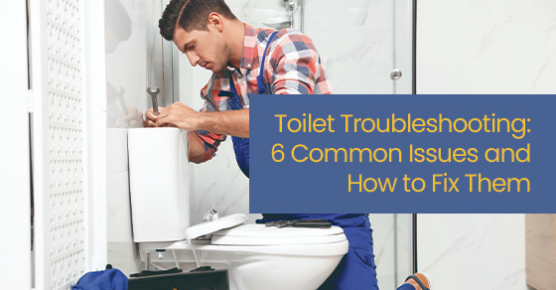


While professionals must address the most serious plumbing issues, there are some more common problems that homeowners can fix themselves.
Addressing issues related to the toilet is one of them, since it is used more often than other plumbing equipment. Knowing how to address these issues is valuable, but you first need to identify the problem.
It becomes easier if you know how the toilet works, and it is not as complicated as you might think.
Simply put, pressing the flush handle releases water from the tank into the pot. However, we need to go a bit deeper. When the tank is full of water, a float ball is suspended in it. Pressing the flush handle raises an arm inside the tank, which then lifts a flapper.
It allows the water to rush into the bowl and exit through the drain and sewage pipes. The float ball keeps lowering as water leaves the tank, and after a point, the ball drops low enough, triggering the fill valve to open. Fresh water enters the tank until the float ball is at its maximum height and the fill valve closes.
Now, with this knowledge, here are some common issues related to your toilet and how to fix them:
If you see or hear noise from the toilet, it could be that the water is continuously running in the bowl or in the tank itself. It is most likely an issue associated with the tank. There could be two areas of failure—the flapper or fill valve.
Check the flapper to ensure it is seated correctly and for any damage, as that may be allowing the water to trickle from the tank to the bowl. If the water in the tank is overflowing into the overflow tube, there is likely an issue with the fill valve. Check for debris or damage, and if cleaning the area does not solve the problem, consider replacing the fill valve.
Another common issue is a clogged toilet. An obstruction in the drain can cause a clog, preventing the water from flushing as it normally should. In most cases, you can deal with a clog using a plunger, auger, or a drain-opening chemical. If you are using a plunger, ensure there is enough water in the bowl to submerge the head of the plunger.
Once you have a seal around the hole, plunge rapidly and then use the flush to see if the clog has been removed. If you use an auger or a plumbing snake, shove the end into the toilet drain hole and twist it around until you feel the blockage is clear.
If you have to use a chemical drain opener, read the usage instructions. They are typically corrosive and can damage the pipes in the long run.
If the water level in the toilet bowl is higher than average, it could indicate a clog or blockage in the drain.
Use the fixes mentioned above to address clogging issues. The float ball could also be responsible, so check the ball and the arm it is attached to for any damage. Turning the screw on the arm counterclockwise can also help.
If the water level is lower than usual, assess the float ball and turn the screw on the arm clockwise to adjust the arm. If this does not work, check the valve and fill tube for damage, as this could prevent the water from filling to the right level in the bowl.
A third reason for the low water level could be a crack in the toilet. In this case, contact Advanced Plumbing company and have one of our professionals handle it.
A leak suggests there is damage to the toilet or the plumbing connected to it. It can also lead to a higher water bill because of all the wasted water. It can be tricky to identify the source of a leak, which is why you should call a professional plumbing company.
It could be a faulty seal, an issue with the water supply line, flapper, gasket, or a cracked valve.
If it is related to the water supply line or the wall valve, ensure the seal is secure, and everything is attached tightly. If it comes from the flapper, you may have to replace it. If the leak is where the tank connects with the bowl, tighten the bolts and gasket or consider replacing them.
Over time, the toilet seat can become loose or even crack. If the seat is loose, you can quickly tighten the bolts holding it in place. If there is a crack, the seat needs replacing.
Remove the screws and lift the seat and hinges to replace it with a new one. If you are unsure what you are doing, don’t hesitate to call Advanced Plumbing company and let us take it off your hands.
In this case, the water supply valve, float ball, or fill valve tube can be responsible. Start with checking the water supply pressure and make sure the valve is turned in the ‘on’ position. Typically, the tank takes about three minutes to fill.
If it is related to the float ball, it may have become water-logged, which is ideal to replace. Another point of failure could be the fill valve. Assess the fill valve to ensure no wear and tear, clogging, or misalignment issues.
While these are common toilet-related issues that you can address, getting professional help from a known plumbing company is always advisable. This way, you can rest assured we will efficiently resolve your problem without damaging anything else.
For more information about toilet troubleshooting and how to fix common issues, call Advanced Plumbing at 866-863-9539 or contact us here.